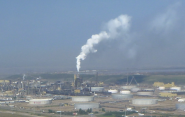Study: Oil Sands Pollutants Greatly Exceed Previous Reports

Using state-of-the-art aircraft-based measurements and supporting laboratory experiments, a team of Yale and Canadian researchers found that many pollutants in the air related to Canadian oil sands greatly exceed the emissions that have been previously reported.
Over recent decades, global petroleum production has shifted towards more unconventional sources, including oil sands. In Canada, oil sands contain an estimated 1.7 trillion barrels of oil and currently produces about 3 million barrels of crude oil daily. In collaboration with Environment and Climate Change Canada - a department of the Canadian government - Yale researchers used comprehensive data from aircraft measurements to capture the full range of organic pollutants generated by these oil sands facilities. The results are published in Science.
Governments often mandate the monitoring of air quality and the development of emissions inventories for tracking and regulating pollutant sources. However, these programs have historically focused on only certain compounds, with the underlying assumption that they cover most reactive carbon emissions. In reality, though, a wide range of gaseous organic carbon emissions can elude conventional approaches due to their chemical complexity.
To examine this wide range of both traditional and understudied compounds, the aircraft was outfitted with an array of instruments, including technology capable of measuring the total amount of gas-phase organic pollutants in the air over the Athabasca oil sands facilities of Alberta, Canada. Additionally, the researchers took samples from the air to be analyzed in Prof. Drew Gentner’s lab at Yale.
“We had a wide range of analytical techniques on the aircraft that expanded upon prior measurements,” said Gentner, associate professor of chemical & environmental engineering, and senior author of the study. “And what we saw were very large emissions of total gas-phase organic carbon from these facilities. On average, the majority of the total gas-phase organic carbon was from often overlooked compounds, which are typically outside of the scope of routine monitoring.”
While many reactive gases were underestimated, the compounds that comprised the majority of the emissions underestimates include intermediate- and semi-volatile organic compounds. These are larger molecules composed of mostly carbon and hydrogen, which impact downwind air quality, including through their chemical transformations.
With detailed speciated measurements, the researchers were able to get a clear molecular picture of the emissions, including their relation to other combustion-related pollutants, like nitrogen oxides. Because the chemical makeup of the samples was consistent with that of extracted oil sands, the researchers are confident that these compounds weren’t coming from vehicle exhaust or other combustion-related sources.
Particularly noteworthy was the magnitude of emissions detected. Depending on the specific facility, observed emissions were from 20 to over 64 times higher than what was reported to the emissions inventory for the various oil sands operations studied. Overall, the researchers said, that equates to the equivalent of emissions from all other human-related sources in Canada.
“The magnitude of the observed emissions from oil sands operations was larger than expected, considering that it was roughly equivalent to the sum of all other anthropogenic sources across Canada when including all the motor vehicles, all the solvents, all the other oil and gas sources, and everything else reported to the inventory,” said Dr. John Liggio, of Environment and Climate Change Canada.
The researchers said the results indicate that more routine total carbon measurements could significantly improve the monitoring of emissions well beyond just oil sands operations.
“Our findings show that this approach of measuring total organic carbon can be applied more widely to other sources, and even coupled with other pollutant measurements to improve emissions inventories broadly,” said Megan He, first author of the paper, who is now at Harvard University.

